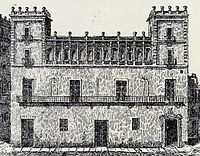
Valencia is the capital of the province and autonomous community of the same name in Spain. It is the third-most populated municipality in the country, with 807,693 inhabitants within the commune, 1,582,387 inhabitants within the urban area and 2,522,383 inhabitants within the metropolitan region. It is located on the banks of the Turia, on the east coast of the Iberian Peninsula on the Mediterranean Sea.

The Cathedral of the Holy Cross and Saint Eulalia, also known as Barcelona Cathedral, is the seat of the Archbishop of Barcelona in Catalonia, Spain. The cathedral was constructed from the thirteenth to fifteenth centuries, with the principal work done in the fourteenth century. The cloister, which encloses the Well of the Geese (Font de les Oques), was completed in 1448. In the late nineteenth century, the neo-Gothic façade was constructed over the nondescript exterior that was common to Catalan churches.

The City of Arts and Sciences is a cultural and architectural complex in the city of Valencia, Spain. It is the most important modern tourist destination in the city of Valencia and one of the 12 Treasures of Spain.

Alzira is a city and municipality of 46,451 inhabitants in Valencia, eastern Spain. It is the capital of the comarca of Ribera Alta in the province of Valencia. The city is the heart of the second largest urban agglomeration in the province, with a population of over 100,000.

Estadi Ciutat de València is a football stadium in Valencia and is the home ground of Levante UD. Built in 1969 and holding up to 26,354 spectators, it is the 23rd-largest stadium in Spain and the 4th-largest in the Valencian Community.
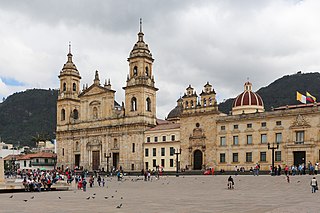
The Metropolitan and Primate Cathedral Basilica of the Immaculate Conception and Saint Peter of Bogotá or better known as the Metropolitan Cathedral Basilica of Bogotá and Primate of Colombia, officially Sacred Holy Temple Metropolitan Cathedral Basilica and Primate of the Immaculate Conception of Mary and Saint Peter, is a cathedral church of Catholic worship consecrated to the Immaculate Conception and under the patronage of Saint Peter; it is a Neoclassical style building located in the Plaza de Bolívar in Bogotá, the country's capital.

The Archdiocese of Valencia is a Latin Church diocese of the Catholic Church located in north-eastern Spain, in the province of Valencia, part of the autonomous community of Valencia. The archdiocese heads the ecclesiastical province of Valencia, with authority over the suffragan dioceses of Ibiza, Majorca, Minorca, Orihuela-Alicante and Segorbe-Castellón. The archbishops are seated in Valencia Cathedral. Enrique Benavent Vidal succeeded Cardinal Antonio Cañizares Llovera as the Archbishop of Valencia in 2022.

Valencia Cathedral, at greater length the Metropolitan Cathedral–Basilica of the Assumption of Our Lady of Valencia, also known as St Mary's Cathedral, is a Catholic church in Valencia, Spain.

The Aljafería Palace is a fortified medieval palace built during the second half of the 11th century in the Taifa of Zaragoza in Al-Andalus, present day Zaragoza, Aragon, Spain. It was the residence of the Banu Hud dynasty during the era of Abu Jaffar Al-Muqtadir. The palace reflects the splendor attained by the Taifa of Zaragoza at its height. It currently houses the Cortes of the autonomous community of Aragon.

Sos del Rey Católico is a historic town and municipality in the Cinco Villas comarca, province of Zaragoza, in Aragon, Spain.

The Museum of Mexico City is located at Pino Suarez 30, a few blocks south of the Zocalo, on what was the Iztapalapa Causeway, near where Hernán Cortés and Moctezuma II met for the first time. This building used to be the palace of the Counts of Santiago de Calimaya, who were the descendants of one of the conquistadors with Cortés. The house was extensively remodeled during the colony to much the appearance that it has today and remained in the family until 1960, when the Mexico City government acquired it from them in order to found the Museum that is found there today. The museum contains a number of elements of the old palace as well as 26 rooms dedicated to the history and development of Mexico City from Aztec times to the present. It also contains a library and the studios of painter Joaquín Clausell, who lived here in the late 19th and early 20th centuries.

L'Àgora is a multifunctional covered space designed by Santiago Calatrava located in the Ciutat de les Arts i les Ciències complex, Valencia, Spain.

The Cathedral of the Transfiguration of the Lord, also known as the Cathedral of Saint Mary, is a Roman Catholic church in Huesca, in Aragon, north-eastern Spain. It is the seat of the Bishop of Huesca. Its architecture is Gothic, and its construction began in the late 13th century and was finished in the early 16th century.
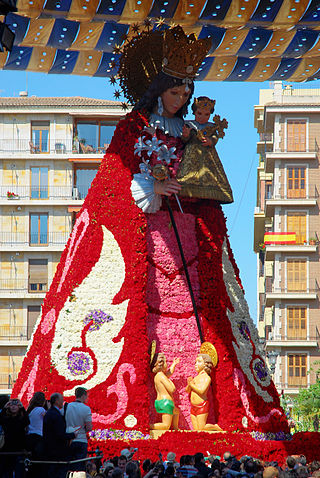
Our Lady of the Forsaken is a Catholic invocation of the Virgin Mary. She is the patroness of Valencia and one of seven patrons of the Autonomous communities of Spain. She appears with a lily in one hand and in the other, she carries the baby Jesus who bears the cross in his arms. Her posture is characterized by a slight forward tilt, and hence, she is known affectionately as the Geperudeta (hunchback) of València. Her image is housed in the 'Basilica de la Mare de Déu dels Desamparats'.
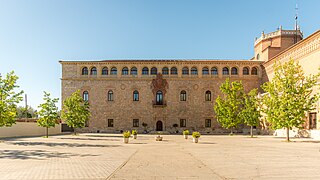
The Archiepiscopal Palace of Alcalá de Henares is a palace located in Alcalá de Henares, in the Community of Madrid, Spain. It is now home to the Diocese of Alcalá de Henares. It is located in the Plaza del Palacio and this form part of the monumental set declared World Heritage Site by UNESCO.
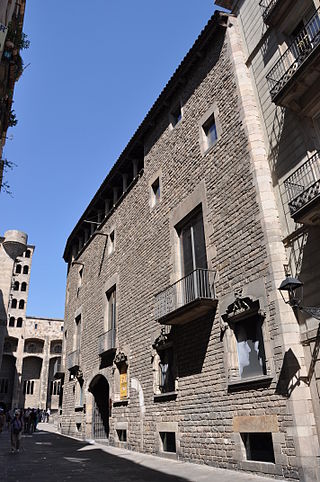
The Museum of the History of Barcelona is a history museum that conserves, researches, communicates and exhibits the historical heritage of the city of Barcelona, from its origins in Roman times until the present day. The museum's headquarters are located on Plaça del Rei, in the Barcelona Gothic Quarter. It also manages several historic sites all around the city, most of them archaeological sites displaying remains of the ancient Roman city, called Barcino in Latin. Some others date to medieval times, including the Jewish quarter and the medieval royal palace called the Palau Reial Major. The rest are contemporary, among them old industrial buildings and sites related to Antoni Gaudí and the Spanish Civil War.

The Convent of Santo Domingo was a convent of the Dominican Order in the city of Valencia, Spain. Construction of the church began on land granted by King James I of Aragon in 1239, but it was subsequently replaced by a larger structure in 1250. The building went through renovations and expansions during different periods in history, hence it is home to Renaissance, Neoclassical, Valencian Gothic and Baroque styles of architecture. It was classified as a Bien de Interés Cultural in 1931, and is now used as a Spanish Army headquarters.

Barcelona City Hall is the seat of Barcelona City Council. It is situated in the Plaça Sant Jaume in the Gothic Quarter, opposite the Palau de la Generalitat de Catalunya housing the regional government.

Valencia City Hall is the seat of local government in Valencia, Spain. It was declared a Bien de Interés Cultural in 1962.

The Palace of the Diputación del General del Reino de Aragón, historically known as Casas del Reino or Casa de la Diputación del Reino, was a building in the Plaza de la Seo in Zaragoza in 1436, as the headquarters of the Diputación del General del Reino de Aragón, the Cortes and the Justicia de Aragon.
